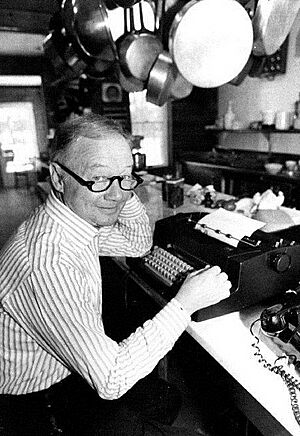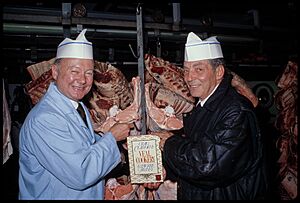Craig Claiborne facts for kids
Craig Claiborne (born September 4, 1920 – died January 22, 2000) was an American writer who focused on food. He was a famous restaurant critic and food journalist. For many years, he was the food editor and restaurant critic for The New York Times newspaper. He also wrote many cookbooks and his own life story. Craig Claiborne helped change how Americans thought about food and cooking.
Early Life
Craig Claiborne was born in Sunflower, Mississippi. He grew up learning about the special foods of the South. His mother ran a boarding house in Indianola, Mississippi. He spent a lot of time in her kitchen.
He first studied medicine at Mississippi State University. But he soon realized it wasn't for him. He then went to the University of Mississippi. There, he studied journalism and earned his degree.
Claiborne served in the United States Navy during World War II and the Korean War. After his military service, he decided his real passion was cooking. He used his military benefits to attend a famous cooking school. This school was the École hôtelière de Lausanne in Lausanne, Switzerland.
Career in Food
After returning to the U.S., Craig Claiborne started working in food publishing. He wrote for Gourmet magazine. In 1957, he became the food editor for The New York Times. He was the first man to lead the food section at a major American newspaper.
Before Claiborne, newspaper food sections were mostly for homemakers. They focused on entertaining and cooking at home. Claiborne changed this. He brought his deep knowledge of food to the newspaper. He made the food section a key part of New York City's culture. He also helped people across the country learn about new foods.
Claiborne's articles and cookbooks taught Americans about many different foods. He introduced them to Asian and Mexican cuisines. At that time, most Americans had simple tastes in food. Fancy cooking was usually only French. Claiborne wanted to help people choose good restaurants. He created the four-star rating system for restaurants. The New York Times still uses this system today. Many other places have copied it too.
He always looked for new and exciting cooking styles. He helped make famous many chefs who were not well-known before. One example is Paul Prudhomme from New Orleans, Louisiana. Claiborne introduced Americans to Cajun cuisine. Most people outside the South had never heard of it before.
Craig Claiborne, along with chef Julia Child, made fancy cooking easier to understand. They helped Americans enjoy French cuisine and other international foods. Claiborne wrote or edited over twenty cookbooks. Some of his books were among the first to focus on healthy eating. They included recipes for low-sodium and low-cholesterol diets. He often worked with French chef Pierre Franey. Together, they created many healthy recipes.
The Famous Meal
In 1975, Craig Claiborne won a special dinner at a charity auction. He paid $300 for a meal for two people. The meal could be at any restaurant he chose, with no price limit. He picked his friend Pierre Franey to join him. They chose Chez Denis, a famous restaurant in Paris, France.
Their meal lasted five hours and had thirty-one courses. They ate fancy foods like foie gras, truffles, lobster, and caviar. They also drank rare wines. The total bill for this amazing meal was $4,000. When Claiborne wrote about it in The New York Times, many readers were surprised by how expensive it was. He noted that even though it was a huge meal, some dishes were not perfect.
Death and Legacy
Craig Claiborne had some health problems later in his life. He passed away at age 79 in New York City. He left his estate to The Culinary Institute of America. This is a well-known cooking school in Hyde Park, New York.
Quotes
- "Cooking is at once child's play and adult joy. And cooking done with care is an act of love."
- "I am simply of the opinion that you cannot be taught to write. You have to spend a lifetime in love with words." (A Feast for Laughter, p. 150)
See also
- List of American print journalists
- List of people from Mississippi
- List of people from New York City



